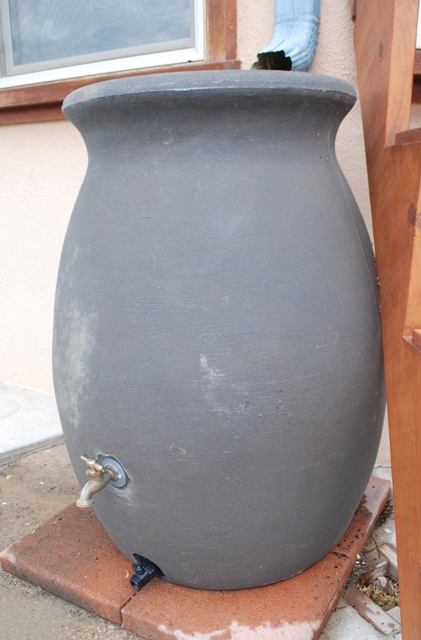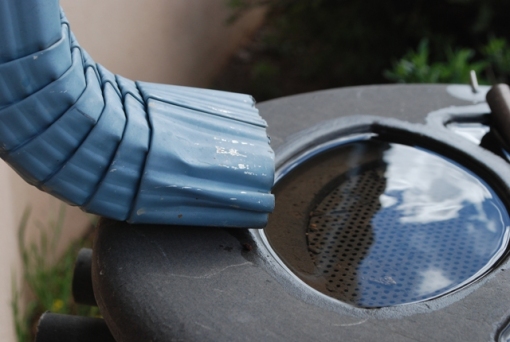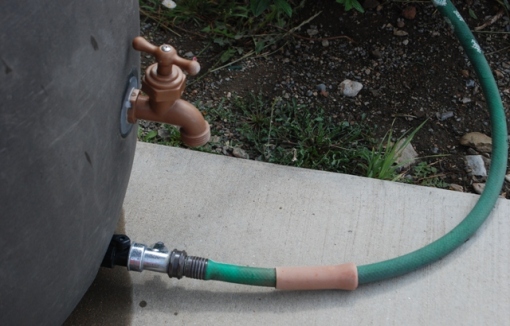The drought is easing here as April showers finally arrived and turned into a few May thunderstorms. Our rain barrels are overflowing, and it makes me happy, but crazy. (I need to check and see if I say “xxx makes me crazy” on every post. This is a troublesome pattern.) Anyway, I hate to see any of that precious resource go to waste. In reality, I know it’s watering the natural grass, trees and plants, flowing into the river, and adding to our water table. But I want to collect as much of it as I can to avoid use of our well water for most of the year.

This is a basic, 50-gallon rain barrel used as needed for xeric ornamentals and herbs. I’ll use it soon for some vegetables.
From 30 percent to 50 percent of public or potable water in a given community can go to landscaping. I know we could use more than that between our fruit trees and vegetable gardens. It’s imperative that we all continue to find ways to cut the amount. I tackle that as often as I can on this blog, but for now, I want to focus on rainwater collection and safety of rainwater for edibles.
Rain barrels and cisterns
Our two 50-gallon rain barrels just don’t cut it. And I have big plans to add more, including a huge above-ground or underground cistern. Most homeowners use barrels similar to ours to water ornamental gardens. We’ve found that they’re easy to install, and work pretty well, although Tim has had to replace the faucet on some. You can add a hose to the bottom of the barrel or fill a watering can from the spigot. The barrels cost around $80 to $135, depending on quality, size and appearance.
Cisterns cost more, and generally are used by commercial operations. But if we ever get our greenhouse (see my comment above about what makes me crazy, as in not having one yet), I think it would be difficult and irresponsible to add year-round gardening without having rainwater collection. A 1,000-gallon tank runs close to $600 or more, and you can expect to pay up to $5,000 for a 10,000-gallon cistern, plus excavation if it’s going underground. Of course, with all cisterns, you have to consider some installation costs, plus shipping or transportation and permits in some cases.
Roof water for vegetable gardens
In the past, I heard that roof water was not safe for watering edibles, and I avoided using rain barrel water from my tar and gravel roof on herbs or vegetables. But we now have a metal roof, and I feel comfortable using the barrels to water ornamentals and edibles. I wanted to back that up with science, however, so I found some great information from Rutgers University’s New Jersey Agricultural Experiment Station.

A metal roof, gutters and downspout bring water to our two rain barrels. The barrel has a screen to prevent debris or birds from getting inside.
The study tested safety of rain barrel water for irrigation of a vegetable garden. In short, they found that rainwater collected from asphalt shingle roofs met irrigation water standards, with a few exceptions. E. coli sometimes appeared in the samples because of droppings from birds, squirrels or other animals. And rain barrel water is not safe to drink, but is considered safe to use to water the soil (roots) of your vegetables. The authors of the study recommended a few practices to ensure the rain water remains safe:
- Clean rain barrels with a 3-percent bleach solution before collecting water you’ll use for herbs and vegetables. Since you need to empty the barrel before winter (unless you are in a mild climate), you can clean it before each spring. Or simply add household bleach at a rate of 1/8 teaspoon per gallon of water twice a month during heavy rainfall). It’s diluted enough to prevent any harm to plants after about 24 hours.
- Pour the rain water directly onto the soil, not on the plant’s leaves, or use it in drip irrigation.
- Water in the morning and harvest at night. This gives the sun’s rays time to disinfect leaves. Morning watering is a better xeric technique, anyway.
- It also helps to clean your gutters before spring rains hit, just to cut down on dirt and debris.

Very useful! I’ve thought about this issue with the asphalt roofs–thanks for the link! 🙂
Lori: i’m glad you found it useful! Thanks, Teresa